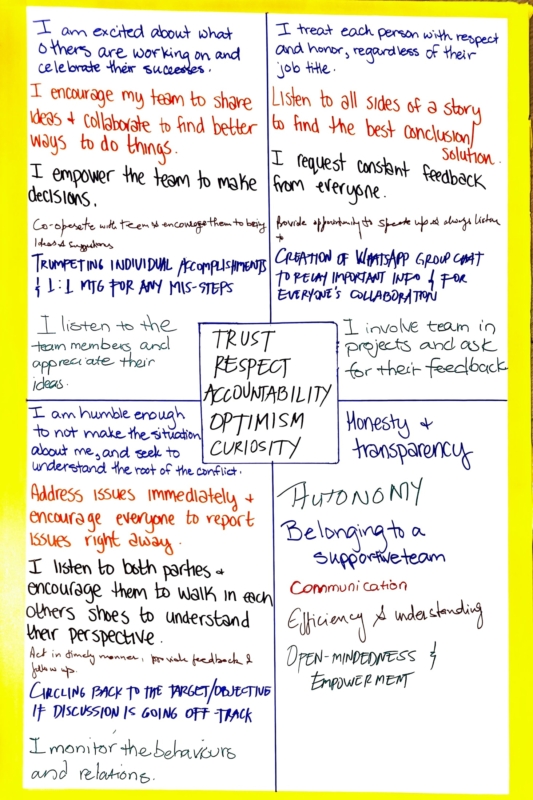Step-by-Step Plan to Create Your Team Social Contract
A social contract is a simple framework to establish those ‘team norms.’ Yes, you could hire me to come into your team and facilitate this for half a day, but you can do this yourself!
Last week in Prince George, British Columbia, I spent two days training a client’s team on one of my favorite topics: building a workplace where people feel comfortable being their best selves. Drawing from my 35 years in policing and my current work with Fiore Group Training, I’ve developed practical strategies for creating supportive team environments.
Listening to the “lived experiences” of the people in Prince George’s added to the impetus for this week’s Living Leadership.
This blueprint outlines a structured yet flexible approach to encouraging open dialogue and mutual respect.
The Foundation: Creating Psychological Safety
Psychological safety means team members feel secure discussing challenges, mistakes, and personal struggles without fear of judgment. Here’s how you can shape a safe environment for your team.
Start with Physical Safety
Setting a Mindful Atmosphere
The first step in creating a psychologically safe environment is intentionally shaping the space – physically and emotionally – so that team members feel comfortable engaging in vulnerable discussions.
Seating Arrangement Matters
Arrange seating in a circle to remove hierarchical barriers and promote equality.
I remember hearing someone ask Nelson Mandela how he developed such excellent leadership skills when he spent so much of his life (27 years) in prison. He answered that as a young boy, he would go to local villages with his father, Nkosi (Chief) Mphakanyiswa Mandela. There, he noticed that everyone always sat in a circle and his father was always the last person to speak (aka listening).
Incorporate Warmth: Use warm lighting and comfortable chairs, or even hold discussions outside formal offices (e.g., walking meetings and open-air spaces).
Establish Ground Rules for Respect and Trust – a Social Contract
Think of a team social contract as your group’s mutually created playbook for success. It’s a document where team members jointly outline their commitments to each other—from how they’ll communicate and make decisions to how they’ll handle disagreements and celebrate wins. This shared understanding helps everyone work together more effectively by making expectations explicit.
Instead of imposing rules, the team creates shared agreements about communication, confidentiality, and mutual respect.
Example agreements:
-
- “We listen to understand, not to respond.”
- “We assume good intent while holding each other accountable.“
- “We acknowledge emotions but focus on learning and moving forward.”
Post a Large Sheet of Paper on the Wall
- Use Brene Brown’s book, Dare to Lead and create a set of team values. List these values in the middle of the sheet of paper.
- Ask each team member to suggest one positive team behavior they would like/expect to see in their team. List all of their ideas in the top left quadrant.
- Ask each team member to suggest one behavior that, when practiced, would create a sense of inclusion. Please list all of their ideas in the top right quadrant.
- Ask each team member to suggest one behavior that would create a way to resolve conflict healthily in the team. List all of their ideas in the lower left quadrant.
- Ask each team member to share the one thing they need, as an individual, to experience within their team for them to show up as the best version of themselves each day. List all of their answers in the lower right quadrant.
Finally, have every team member sign the document. After all, it is a contract, and their suggestions and ideas are all over it!
Then, post it somewhere they will see it regularly to remind them of their commitment. Every few weeks or months, take a few minutes to review the social contract and ask the team to offer stories or insights into how it is working or not.
Ta Da!! It is a brilliant accountability tool.
Building Trust and Team Cohesion
Confidentiality is the cornerstone of your team social contract. Like Las Vegas, what happens in team discussions stays there unless everyone agrees to share it externally. When team members sign the contract, emphasize that their signature represents a commitment to the agreement and its confidential nature.
As a leader, demonstrating vulnerability helps create psychological safety. Share your own learning experiences – whether they’re meaningful lessons or lighthearted mishaps. A touch of self-deprecating humor can ease tension and make others more comfortable sharing their own challenges.
Think of your team as a tapestry, where each member contributes a vital thread to the overall pattern. When you actively value and incorporate diverse viewpoints, you strengthen this weave. Your team members aren’t just colleagues sharing an organizational chart; they’re individuals whose unique perspectives and contributions create a stronger, more resilient whole.
In our next discussion, we’ll explore practical techniques for facilitating team conversations once your social contract is established.






